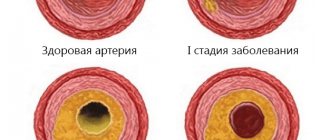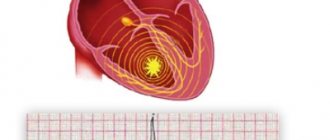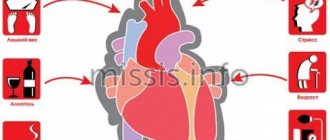Angina pectoris (angina pectoris) is a sharp pain or discomfort in the chest area. The reason for this is a lack of blood supply to certain areas of the heart. Angina pectoris is noted as a leading symptom in coronary heart disease (CHD), which develops due to blockage or narrowing of the blood vessels of the heart. All patients experience approximately the same sensations - pressing or squeezing pain behind the chest, which often radiates to the arm, shoulder, jaw or neck. The pain usually does not last more than 5 minutes and disappears after taking certain medications or relieving tension. However, the duration of the attack is purely individual; some patients experienced pain from 30 seconds to 30 minutes.
Causes
The exact percentage of the prevalence of coronary vascular spasm, otherwise known as Prinzmetal's angina, among the population has not yet been established.
This indicates that there are not many patients with a similar diagnosis. However, due to the similarity of the clinical picture with other forms of coronary artery disease, you should always be aware of the possibility of this problem. The occurrence of heart spasms is based on two key factors:
- The presence of atherosclerotic plaques inside the vessel. This appears as accumulations of fatty and inflammatory cells that are deposited in the inner wall of the coronary arteries.
- Spasm. When you are stressed, smoke a lot, or engage in strenuous physical labor, the lumen of the vessels that supply blood to your main “engine” in the body narrows. Given the presence of plaques in the arteries, the supply of oxygen to the muscle fibers of the heart sharply decreases, which provokes the onset of an attack.
These two factors remain key in the development of the disease.
Remember that the spasm rarely lasts longer than 5-10 minutes. This time is not enough for necrosis (infarction, death) of individual muscle fibers to occur, so there is no need to panic. However, a lack of cell nutrition develops with the addition of characteristic symptoms.
Now I will list the factors that provoke spasm of the heart vessels:
- Age. Traditionally, patients over 45-50 years old suffer from variant angina.
- Floor. Men are more susceptible to various types of IHD.
- Atherosclerotic damage to the blood vessels of the heart and the whole body. The more plaque there is in the arteries (and the thicker it is), the higher the chance of developing typical signs of the disease.
- Smoking. Nicotine is a substance that stimulates arterial spasm throughout the patient’s body. Due to the presence of plaques in the vessels, an attack can occur virtually after every cigarette smoked. It all depends on the severity of the atherosclerotic process.
- Stress. Under the influence of emotional stress, the muscular lining of blood vessels contracts, reducing the delivery of oxygen and nutrients to the heart cells.
Treatment
Successful treatment of angina is usually associated with a reduction in risk factors that can cause cardiovascular problems. These include: high blood pressure, excess cholesterol, excess weight, smoking. The doctor will prescribe you all the necessary medications to bring your blood pressure back to normal, suggest the right diet and help you create a physical exercise program for the treatment of angina pectoris.
Currently, mononitrates, dinitrates and trinitrates are used to relieve the symptoms of angina pectoris. Their mechanism of action is dilation of the blood vessels of the heart, which increases the flow of oxygen and reduces tension in the myocardial wall. Undesirable effects of nitrates in the treatment of angina include headache, decreased blood pressure, facial flushing, dizziness, and insensitivity to certain doses of the drug. Beta blockers, which reduce the strength and frequency of the heartbeat, and calcium channel blockers, which prevent vasospasm, are also used.
In cases where the symptoms of angina are severe and medications are not able to help, surgery (in the form of coronary artery bypass grafting) and balloon angioplasty are prescribed. Coronary artery bypass grafting involves the implantation of a blood vessel into a blocked section of the coronary artery. In this way, blood flow in this part of the heart is restored using a bypass. Angioplasty is an operation to treat angina using a catheter with a small balloon at the end. It is injected into the axillary or femoral artery and then advanced to the site of narrowing of the coronary vessel. Here it quickly inflates or stretches, eliminating the spasm.
Particular attention needs to be paid to the treatment of unstable angina, which can occur even in the absence of strain. Such chest pain does not have predictable boundaries of onset, unlike stable angina, and does not need a reason for its occurrence.
Symptoms
Some patients I have worked with have believed that symptoms are the same for everyone. That is why I had to explain to them that manifestations can vary depending on the individual characteristics of the body. Of course, a number of general points can still be identified.
The clinical picture of variant angina, the cause of which is precisely a sharp decrease in the diameter of the coronary vessels, is in many ways reminiscent of traditional angina pectoris. Most forms of IHD are similar to each other. My task, as a doctor, remains the differential diagnosis of pathological conditions. The approach to treatment directly depends on this.
Complaints with which people turn to me or another cardiologist for help:
- Pressing pain in the heart area, which can spread to the left arm, neck, jaw. I often hear it compared to a twisting, cramping sensation in the chest. Sometimes patients indicate a burning sensation, which may go away on its own within 5-10 minutes.
- Increased heart rate. Against the background of pain, the heart rate increases. Recently, a woman said that, in addition to chest discomfort, her “heart wanted to jump out of her mouth.” Agree, this is a very eloquent description.
- Dyspnea. A sign that can sometimes be the only clinical manifestation of the pathology.
- Cold sweat. The symptom occurs in severe forms of the disease.
- Nausea, vomiting, confusion are rare but common companions of variant angina.
It will be useful for you to know that variant angina is not associated with physical activity. Most forms of IHD are characterized by an increase in pain during active walking, heavy lifting, and the like. With Prinzmetal's angina, sensations occur spontaneously, often at the same time of day. 55-65% of attacks occur in the early morning hours.
PsyAndNeuro.ru
Unfortunately, misconceptions about anxiety disorders and their differences from depression lead to misunderstandings about the role of anxiety in coronary heart disease (CHD), although the relationship between anxiety disorders and cardiovascular disease began to be studied more than 100 years ago. It is surprising that, despite the inextricable connection of anxiety with the functions of the cardiovascular system, the etiological and prognostic links between anxiety disorders and coronary artery disease have been addressed only recently, in the last decade.
Recent evidence suggests that anxiety disorders increase the risk of developing CHD; however, the potential mechanisms underlying the putative association of anxiety with cardiovascular health are complex and poorly understood. From a prognosis perspective, in patients with CAD, symptoms of anxiety and anxiety disorders increase the risk of major adverse cardiovascular events (eg, myocardial infarction, left ventricular failure, coronary revascularization, stroke), suggesting the importance of anxiety disorders in cardiac practice.
In this review, special attention is paid to panic disorder, since the symptoms of panic disorder largely overlap with the symptoms of coronary artery disease. Other anxiety disorders will be mentioned when their symptoms are relevant to the association of anxiety with CHD.
Anxiety may go undetected or misdiagnosed in a group of patients with known, suspected, or subclinical CAD. Surveys of experts show that doctors lack knowledge about panic disorder and its treatment. Clinicians are not well informed about the characteristics of panic disorder and its distinctive diagnostic features: recurrent and unexpected panic attacks accompanied by persistent worry or worry in anticipation of further panic attacks or their consequences, and maladaptive behavior, including avoidance behavior.
The clinical nuance is that many symptoms characteristic of a panic attack overlap with the clinical picture of coronary artery disease, as well as arrhythmias and cardiomyopathy, which makes differential diagnosis difficult. For example, chest pain and shortness of breath are panic symptoms but are also typical of myocardial infarction and angina.
The coincidence of subjective cardiorespiratory symptoms in anxiety and in cardiovascular diseases only complicates the understanding of the complex relationship between anxiety and coronary artery disease. Additionally, people with panic disorder may experience physical symptoms of undiagnosed medical conditions such as coronary spasm, microvascular angina, and slow coronary blood flow, in addition to CAD, defined as ⋝50% coronary artery stenosis.
Thus, it is likely that panic disorder is sometimes a misdiagnosis. Therefore, some authors caution that many cases of panic disorder may be misdiagnosed arrhythmias, and panic symptoms may subside once the arrhythmia is controlled. Other experts, on the contrary, believe that in the presence of cardiorespiratory symptoms that cannot be explained by diseases of the cardiovascular system, panic disorder or hypochondria can be assumed.
A diagnosis of an anxiety disorder does not exclude cardiovascular disease, and the presence of high anxiety does not indicate the absence of coronary artery disease. Concerns about the heart and its function are often observed before coronary catheterization and coronary revascularization. Ideally, confirmation of an anxiety disorder diagnosis should be made by an experienced mental health professional.
The main psychiatric diagnostic systems, DSM and ICD, stipulate that a diagnosis of panic disorder cannot be made if panic symptoms appear as a direct result of diseases such as coronary artery disease. According to this principle, a more appropriate diagnosis would be “anxiety related to physical illness.” This distinction is important for diagnostic nomenclature, but not for anxiety treatment, which is independent of the diagnosis of CAD.
With regard to anxiety detection, due to differences in clinical training, studies quantifying the prevalence of panic disorders in patients with CAD are heterogeneous. Non-psychiatrists estimate the prevalence of panic disorder to be lower compared to specialists with psychiatric training. The prevalence of panic disorder in studies that were not blinded for the presence of coronary artery disease was estimated to be lower than in studies that were blinded. Because the authors of the published studies did not assess general health status, it is unclear whether physicians tend to attribute physical symptoms to the presence of CAD.
Anxiety, as a rule, is not associated with the severity of IHD, and in this sense, anxiety is perhaps similar to subjective pain, the severity of which cannot reliably judge the degree of physical injury. The lack of association between anxiety and the severity of CAD may be explained by the fact that panic disorder is characterized by anxiety sensitivity, usually defined as fear of sensations and symptoms associated with arousal of the autonomic nervous system. As a consequence, cardiorespiratory symptoms are typically exacerbated by cognitive and behavioral processes, including hypervigilance, hypervigilance, catastrophizing, and avoidance, which lead to lower thresholds for somatic awareness.
There is a fairly strong relationship between anxiety and subjective assessment of CAD symptoms, such as chest pain and shortness of breath. Not surprisingly, patients with anxiety are more likely to perceive physical symptoms as serious and are more likely to end up in emergency departments not with a heart attack but with a panic attack or non-cardiac chest pain.
On the other hand, there is evidence that anxious patients end up in the emergency department with myocardial infarction more often than patients with myocardial infarction but without anxiety.
| Symptoms of a panic attack | Similar symptoms of ischemic heart disease, myocardial infarction, cardiomyopathy |
| Rapid heartbeat, irregular heartbeat | Irregular heartbeat, arrhythmias (eg, ventricular tachycardia, atrial fibrillation) |
| Sweating | Cold sweat |
| Feeling of lack of air, suffocation | Dyspnea, orthopnea, dyspnea on exertion, wheezing |
| Feeling of tightness in the throat | Pain, feeling of heaviness, constriction, tightness in the jaw and neck |
| Chest pain or discomfort | Angina, chest pain |
| Nausea or abdominal discomfort | Nausea |
| Dizziness, unsteadiness, lightheadedness, weakness | Dizziness, feeling of lightheadedness |
| Chills or fever | Cold sweat |
| Fear of death | Fear of death |
In the group of patients with confirmed coronary artery disease, the prevalence of anxiety disorders is 10-23%. The most common types of anxiety disorders in CHD are panic disorder and generalized anxiety disorder (GAD). Other common anxiety disorders include agoraphobia, which is often comorbid with panic disorder, social phobia, specific phobias, and anxiety-related disorders such as post-traumatic stress disorder (PTSD) and obsessive-compulsive disorder (OCD).
Prevalence of anxiety in IHD and in the general population [1]
| Disorder | Prevalence in patients with CAD (%) | Prevalence in the general population (%) |
| GTR | 7,97 | 3,1 |
| Panic disorder | 6,81 | 2,7 |
| Agoraphobia | 3,62 | 0,8 |
| Social phobia | 4,62 | 6,8 |
| Specific phobias | 4,31 | 8,7 |
| OCD | 1,8 | 1 |
| PTSD | 12 | 3,5 |
Etiological and prognostic studies have demonstrated a connection between GAD, panic disorder, PTSD and cardiovascular diseases. The presence of etiological and prognostic associations is noteworthy because most studies tend to emphasize the role of depression in CAD, but 50% of patients with CAD and a depressive disorder also have an anxiety disorder. Anxiety disorders are highly comorbid with depressive disorders and this comorbidity significantly complicates treatment, so if one disorder is present, evaluation for the presence of the other disorder should be performed.
The existence of etiological connections between anxiety and IHD began to be discussed more than 100 years ago, but comprehensive research on this topic began only recently. Several large and well-powered longitudinal case-control studies have demonstrated that anxiety is associated with coronary artery disease, myocardial infarction, and sudden cardiac death.
Retrospective studies show that increased anxiety during the 24-hour period before a heart attack increases the risk of heart attack by 2-9 times the effect on heart attack risk that anxiety episodes experienced at other times have. This may be explained by the fact that episodes of acute and excessive anxiety affect the state of plaques in the coronary vessels, as a result of which they are destroyed and coronary occlusion develops; however, due to the retrospective nature of the studies, the results should be interpreted with caution.
Panic disorder increases the likelihood of developing coronary heart disease, severe adverse cardiovascular events, and heart attack. The risk remains significant after adjusting for depression. A parallel study of depression and anxiety disorders is important because the etiological risk of CHD is influenced differently by individual disorders and comorbidities. In particular, panic disorder without comorbid depression is associated with cardiovascular disease, cerebrovascular disease, and peripheral vascular disease. Stratification of anxiety disorders according to the presence of comorbid depression suggests that anxiety increases the risk of CHD as well as depression. Authors of several studies caution that reverse causation cannot be ruled out for etiological associations because most cohort studies did not perform coronary angiography at baseline. For this reason, subclinical CAD could be misdiagnosed as panic attacks.
Anxiety symptoms are associated with relatively poor treatment outcome or recurrence of major adverse cardiovascular events in patients with coronary artery disease or heart attack. Analysis of anxiety disorder subtypes revealed different associations with CHD. GAD is primarily associated with poor treatment outcomes. This conclusion about the role of GAD may be explained by the lack of prognostic research on other anxiety disorders, particularly panic disorder and PTSD.
There remains some uncertainty regarding whether anxiety disorders contribute to the poor prognosis of CAD. The American Heart Association and the German Heart Association recommend that researchers focus their efforts on identifying the independent effects of anxiety disorders and their subtypes on cardiovascular prognosis.
Several studies have confirmed the prognostic importance of GAD for recurrence of major adverse cardiovascular events. The presence of GAD approximately doubles the risk of severe adverse cardiovascular events. GAD is associated with an increased risk of poor outcomes from arterial bypass grafting.
Prognostic studies regarding anxiety symptoms also support an increased risk of recurrence of major adverse cardiovascular events and mortality. However, not all studies confirm a positive association between anxiety and severe adverse cardiovascular events. Some studies have found a reduced risk, suggesting a protective effect of anxiety. These results appear to be a statistical artifact of multicollinearity between anxiety and depression rather than evidence that anxiety improves cardiovascular prognosis.
The biobehavioral mechanisms linking panic and CAD are complex, bidirectional, and poorly understood. Biological risk factors mediating the relationship between anxiety and microvascular damage, such as slow coronary blood flow, microvascular angina, and arterial stiffness, are poorly documented.
Panic disorder may be associated with preexisting cardiometabolic risk factors, including hypertension, hyperlipidemia, obesity, kidney disease, and diabetes, so studying the relationship between anxiety and CHD will likely address what CHD and other chronic diseases have in common.
Regarding the behavioral mechanisms that are responsible for the development of atherosclerosis, cross-sectional studies involving patients with anxiety disorders show the predominance of such a behavioral risk factor as tobacco smoking. A strong comorbid association of anxiety disorders with alcoholism and substance abuse has been documented. The strong association between anxiety disorders and alcohol abuse implies a common etiology, common risk factors, or defective coping strategies.
Paradoxically, concerns about your health do not necessarily prompt lifestyle changes in terms of physical activity and diet. Psychometric indicators indicating increased anxiety about health are recorded simultaneously with indicators indicating an increased risk of developing coronary artery disease.
Another behavioral risk factor directly associated with CAD is cardiorespiratory fitness. Several longitudinal studies have shown that poor cardiorespiratory fitness is a predictor of depressive disorders in old age. It can be assumed that there is a similar relationship with anxiety disorders, as patients with panic disorder with high levels of somatic anxiety are almost three times more likely to report low levels of physical activity compared to people with low somatic anxiety.
The association of cardiorespiratory fitness and physical activity with anxiety disorders is more complex than that with depression. There is increasing recognition that exercise avoidance behavior is common among patients with anxiety disorders, especially those suffering from panic attacks. Exercise avoidance is associated with anxiety sensitivity and fear of somatic sensations, such as those caused by aerobic exercise.
This is supported by cardiopulmonary stress testing studies in which patients with panic disorder tend to refuse to continue testing at the same maximum oxygen uptake levels at which other subjects do not stop testing.
Avoidance of exercise and fear of physical sensations have clear consequences for patients with coronary artery disease undergoing cardiac rehabilitation. Persistent anxiety and somatization are strong predictors of decreased physical performance after cardiac rehabilitation.
Experiments aimed at inducing and quantifying the physiological symptoms of panic disorder use carbon dioxide inhalation (inhalation of a mixture of oxygen with 35% CO2). This can cause shortness of breath, dizziness and mild anxiety in most participants, and panic attacks in those who have or are at risk of panic disorder. During the experiment, subjective assessment of the strength of panic symptoms and anxiety was higher in the group of people with panic disorder than in control groups.
In a 2005 study [2], in 81% of patients with coronary artery disease with comorbid panic disorder, a carbon dioxide inhalation test induced myocardial ischemia. A 2014 study [3] used single-photon emission computed tomography to evaluate reversible panic-induced myocardial ischemia. In addition, heart rate, blood pressure and 12-lead ECG were measured. Only 10% of patients experienced myocardial ischemia in a panic state.
Because of this large difference in results, it remains unclear whether panic attacks lead to reversible myocardial ischemia. It is important to note that the ischemic consequences of induced panic in patients with high-risk CAD with comorbid panic disorder have not been documented.
Other studies of the cardiovascular response to panic have focused on the sympathetic nervous system as a mediator between the heart and brain. Increased sympathetic discharges during panic attacks are associated with changes in the QRS complex, in particular the QT interval. There is a link between decreased heart rate variability and anxiety disorders. A 2014 meta-analysis found that anxiety disorders are associated with significant reductions in HRV measured by time domain as well as frequency domain methods.
Other proposed mechanisms by which panic and anxiety contribute to the development of atherosclerosis and recurrence of severe adverse cardiovascular events include the increased inflammatory response noted in people with anxiety disorders, including patients with comorbid coronary artery disease. The most data has been collected on increased levels of C-reactive protein, which indicates an increased risk of developing coronary artery disease. It is also known that in anxiety disorders the levels of interleukins, tumor necrosis factor and adrenomedullin increase. Increased migration of anti-inflammatory immune cells may lead to increased platelet aggregation and instability of coronary plaques.
Treatment of panic disorder in patients with CAD has been largely ignored in the scientific literature, to the detriment of our understanding of anxiety disorders in CAD. Most of the evidence for treatment effectiveness actually comes from studies of depression in which reduction in anxiety was only a secondary outcome, or from studies using only self-reported anxiety.
A 2014 systematic review found that no controlled trials specifically targeted anxiety disorders in patients with CAD. This issue remains a blank spot in the literature and clinical practice.
The complex nature of panic disorder accompanying coronary artery disease requires adaptation of standard cognitive behavioral therapy (CBT) methods. Treatment of panic disorder concomitant with ischemic heart disease or cardiomyopathy is complicated by the following points:
(a) diagnostic overlap between symptoms experienced in anxiety and heart disease;
(b) high risk associated with ignoring chest pain and delaying contacting a doctor in case of a possible myocardial infarction;
(c) CBT, based on the idea of catastrophic distortion of bodily symptoms, must be modified to take into account real cardiovascular risk;
(d) experiments with induction of symptoms (eg, through hyperventilation) may be dangerous due to the risk of myocardial ischemia.
Transdiagnostic CBT and metacognitive therapy that target cognitive and behavioral processes common to anxiety and depression may be useful in treating anxiety.
Reviews of the current scientific literature show that when treating anxiety and depression in patients with coronary artery disease, effect sizes are lower than in groups of patients with other chronic diseases, such as diabetes. Large-scale studies in cardiology (ENRICHD, SADHART, CREATE) have demonstrated the complexity of treating depression and anxiety in coronary artery disease.
However, most studies have focused on the results of the same type of intervention - either the use of only psychotropic drugs, or only psychotherapy. Medical interventions, including CBT and psychotropic medications, have a small but significant effect on the risk of major adverse cardiovascular events.
Regarding psychotropic medications, the European Society of Cardiology EUROASPIRE IV study showed that in a group of patients hospitalized for coronary artery disease, anxiolytic medications were prescribed to only 2.4% of patients at hospital discharge and 2.7% of patients at follow-up. This estimate is consistent with other studies using systematic screening for depression and anxiety in cardiology, which show that psychotropic medications are still used significantly more often than CBT or other types of psychotherapy. It is unclear whether this is due to patient preference, clinician preference, or lack of resources to provide CBT.
Interestingly, the use of benzodiazepines after myocardial infarction is associated with a reduced risk of recurrent infarction. This relationship has a J-shaped curve in the graph, indicating the benefit of low to medium doses of benzodiazepines compared to high doses. Anxiolytic drugs with a sedative effect, such as benzodiazepines, should be used cautiously. They are generally not used in CBT. Regardless of the risk of addiction, the rationale for avoiding these medications in CBT is that taking anxiolytics can become part of a safety behavior strategy or a maladaptive coping strategy, and thereby interfere with healing by prolonging anxiety and increasing the need for medications during a panic attack or before situations causing anxiety.
Thus, CBT is generally considered the preferred treatment strategy for anxiety, with more reliable and durable treatment results in the long term without relapse [4]. For this reason, the use of benzodiazepines in the treatment of patients with coronary artery disease is usually limited, and serotonergic drugs are first-line drugs.
The effectiveness of serotonergic drugs, including SSRIs and SSRIs, in the treatment of depressive symptoms in patients with coronary artery disease was confirmed by the SADHART and CREATE studies. The risk of mortality is not reduced by taking SSRIs, but the risk of readmission is reduced (although there are reviews that suggest that taking SSRIs does not reduce the risk of readmission).
Possible pleiotropic effects of serotonergic drugs include a decrease in platelet aggregation ability and an improvement in endothelial function. Potential side effects include an increased risk of bleeding, as well as the ability of escitalopram to prolong the QTc interval, and therefore should not be prescribed at doses above 40 mg/day.
In addition to CBT and serotonergic medications, some experts suggest the use of supervised aerobic exercise as a treatment for CAD panic by providing experiential and interoceptive experience of somatic sensations such as shortness of breath, palpitations, and sweating. Aerobic exercises, as part of cardiac rehabilitation, provoke somatic symptoms in a safe and controlled environment. In patients with panic disorder, such exercise (for example, several 25-minute sessions on a treadmill) improves maximum oxygen uptake. It is also known that regular physical activity can have a positive effect on anxiety disorder symptoms. However, because people with anxiety and depression are less likely to participate in cardiac rehabilitation, studies showing the benefits of exercise for anxiety may only involve those who do not avoid exercise.
Author of the translation: Filippov D.S.
Source : Tully PJ, Cosh S., Pedersen S. (2020) Cardiovascular Manifestations of Panic and Anxiety. In: Govoni S, Politi P, Vanoli E (eds) Brain and Heart Dynamics. Springer, Cham.
Bibliography:
[1] Tully PJ, Cosh SM, Baumeister H. The anxious heart in whose mind? A systematic review and metaregression of factors associated with anxiety disorder diagnosis, treatment and morbidity risk in coronary heart disease. J Psychosom Res. 2014;77(6):439–48
[2] Fleet R, Lesperance F, Arsenault A, Gregoire J, Lavoie K, Laurin C, et al. Myocardial perfusion study of panic attacks in patients with coronary artery disease. Am J Cardiol. 2005;96(8):1064–8
[3] Fleet R, Foldes-Busque G, Grégoire J, Harel F, Laurin C, Burelle D, et al. A study of myocardial perfusion in patients with panic disorder and low risk coronary artery disease after 35% CO 2 challenge. J Psychosom Res. 2014;76(1):41–5.
[4] Clark DM, Salkovskis PM, Hackmann A, Middleton H, Anastasiades P, Gelder M. A comparison of cognitive therapy, applied relaxation and imipramine in the treatment of panic disorder. Br J Psychiatry. 1994;164(6):759–69
Diagnostic methods
To diagnose variant angina, according to modern recommendations and protocols, I use an integrated approach to assessing the patient’s condition. Much in the process of identifying the underlying disease depends on the quality of the first conversation with the patient.
The key features that allow me to diagnose coronary artery spasm are:
- Episodic symptoms that are not associated with physical activity. Patients may suffer from chest pain in the morning, but go to the gym in the afternoon and do a full range of exercises.
- The appearance of discomfort at approximately the same time of day.
- The short duration of the attack, which goes away on its own with further normalization of the person’s condition.
To confirm the appropriate diagnosis, I always additionally prescribe a number of instrumental and laboratory tests.
Instrumental
Traditionally, the first step is to record an ECG. This method allows you to assess the electrical function of the heart, which changes against the background of various forms of coronary artery disease. It is important to note that there may not be any abnormalities on the ECG outside of an attack. This speaks in favor of spasm of the coronary arteries. However, for the reliability of the study, it is necessary to “catch” the patient during the period of pain, which is sometimes extremely difficult, given the night attacks. The film will record ST segment elevation, which is typical of decreased myocardial blood supply.
For the convenience of the patient and to simplify my task, I use Holter monitoring. The technique involves round-the-clock recording of an ECG in a specific patient with further interpretation of the results. With the help of this study, I can easily determine the time of the episode of coronary artery spasm.
Additional Methods
To fully assess the patient’s condition, the following procedures are also used:
- Angiography of cardiac vessels. The essence of the method is to visualize the patient’s coronary arteries on the monitor after introducing a contrast agent into the bloodstream. This allows me to pinpoint the location of the spasm. However, again, you need to “catch” the patient at the moment of the attack.
- Echocardiography. The technique is based on ultrasound examination of the heart. On the screen you can see the cavities of the organ, and I evaluate its functional activity. With Prinzmetal's angina, no special pathological changes occur.
- Test with dosed load. You are asked to exercise on a stationary bike or treadmill in a controlled environment. At this time, an ECG is recorded, pressure is measured and the general condition is assessed. If pain occurs in the heart, the procedure is stopped. However, with variant angina, patients traditionally tolerate the load well.
Based on the results of diagnostic procedures, individual treatment is selected.
Diagnostics
Not all pain in the chest or heart can be called angina. If it lasts less than 30–40 seconds and is eliminated by taking a deep breath or changing body position, there is no need to worry about angina. To make such a diagnosis, the doctor must analyze your complaints, find out the symptoms and the circumstances of their manifestation. In order to exclude concomitant diseases when diagnosing angina, a number of medical tests are carried out, including an electrocardiogram (ECG) in two states (rest and stress), a stress test, blood pressure measurements and x-rays of the coronary arteries.
Thanks to an ECG, the doctor can determine the electrical impulses of the heart, and with them the symptoms of angina pectoris. They show the absence or presence of ischemia (lack of blood supply), characteristics of changes in heart rate and some other parameters. To get a complete picture of cardiac activity, the specialist compares the ECG readings after exercise and at rest, and then decides on the need to treat angina pectoris.
A comprehensive stress test makes it possible to diagnose angina pectoris and assess blood flow in the heart muscle. A small amount of a radioisotope (usually thallium) is used, which is injected into a vein by microinjection during physical activity. Using a special device, the doctor monitors the distribution of thallium in the heart. Uneven concentration or absence of this element in one or another part of the muscle reveals areas of insufficient blood supply.
The most accurate way to determine angina pectoris (angina pectoris) is an angiogram, or x-ray of the coronary artery. The catheter is placed in an artery in the groin or forearm, and then it moves along the bloodstream to one of the heart arteries. Next, a radiopaque liquid is injected, which makes it possible to observe changes in the arteries under study, diagnosing angina pectoris.
How dangerous is this?
The prognosis for patients with coronary artery spasm is relatively good. The pathology does not cause critical damage to the myocardium, but in the absence of adequate treatment, the risk of developing disturbances in the rhythmic activity of the heart remains. This problem can cause a significant deterioration in the patient’s condition or even death.
Therefore, it is important to consult a doctor in time. Compliance with his recommendations in 90% of cases contributes to the complete elimination of the clinical picture and stabilization of a person’s well-being with a return to normal life.
Expert advice
The simplest and most effective advice that I give to all patients is to quit smoking. Nicotine causes a sharp vascular spasm, provoking a worsening of the disease. In some cases, eliminating tobacco may be sufficient to minimize symptoms. It is important to understand that the more negative factors simultaneously affecting you, the higher the chance of developing heart spasms. You cannot change your gender and age. However, the basic desire to quit smoking and the initiation of adequate therapy contributes to the complete elimination of the unpleasant symptoms of this disease.
Clinical case
A 46-year-old man came to our clinic with complaints of pressing pain in the chest, which arose at rest, mainly at night, and spread to his left arm.
The patient suffers from the problem for 3 months. During the day the symptoms disappear. Exercising in the gym does not aggravate the patient's condition. The disease is associated with stress. The man smokes 1.5 packs of cigarettes per day and suffers from hypertension (160/100 mmHg). ECG at rest without abnormalities. We decided to use Holter monitoring. At three o'clock in the morning an ischemic attack lasting 4 minutes was recorded.
In the morning, when the ECG was re-registered, no pathological changes were detected. Other laboratory and instrumental tests are normal. The patient was diagnosed with IHD. Vasospastic angina, atherosclerosis of the coronary arteries. Arterial hypertension stage II, degree 2, risk. I was prescribed Amlodipine (10 mg orally once a day), Nitroglycerin (1 tablet under the tongue during an attack), Aspirin (75 mg once a day), Rosuvastatin (20 mg per day), lifestyle correction - quitting smoking, minimizing stress. When re-examined 2 weeks later, the patient noted a complete absence of new attacks of chest pain. Feels good, exercise tolerance without restrictions.
I will be glad if this article was useful. Share your experience about episodes of compressive pain in the heart in the comments: how you saved yourself and what helps better. Our experts will help you understand the situation.









